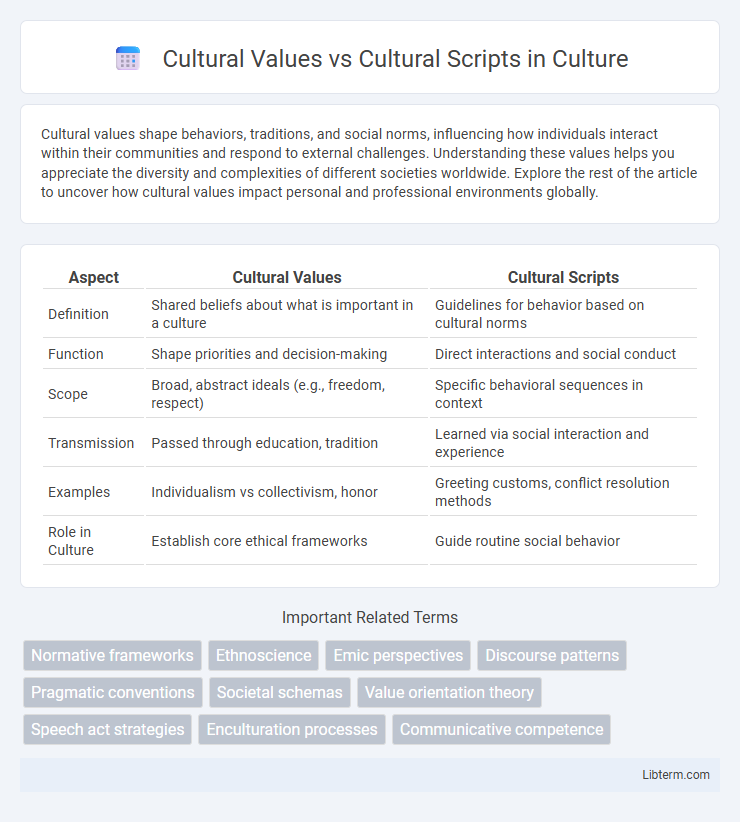Cultural values shape behaviors, traditions, and social norms, influencing how individuals interact within their communities and respond to external challenges. Understanding these values helps you appreciate the diversity and complexities of different societies worldwide. Explore the rest of the article to uncover how cultural values impact personal and professional environments globally.
Table of Comparison
| Aspect | Cultural Values | Cultural Scripts |
|---|---|---|
| Definition | Shared beliefs about what is important in a culture | Guidelines for behavior based on cultural norms |
| Function | Shape priorities and decision-making | Direct interactions and social conduct |
| Scope | Broad, abstract ideals (e.g., freedom, respect) | Specific behavioral sequences in context |
| Transmission | Passed through education, tradition | Learned via social interaction and experience |
| Examples | Individualism vs collectivism, honor | Greeting customs, conflict resolution methods |
| Role in Culture | Establish core ethical frameworks | Guide routine social behavior |
Introduction to Cultural Values and Cultural Scripts
Cultural values represent deeply held beliefs and norms that guide behavior within a society, shaping individuals' perceptions of right and wrong, important and trivial. Cultural scripts are the implicit, socially shared guidelines that dictate how people should behave in specific situations, derived from these underlying cultural values. Understanding both concepts is crucial for interpreting social interactions and communication patterns across diverse cultural contexts.
Defining Cultural Values
Cultural values are deeply ingrained principles that guide behavior and judgment within a society, reflecting what is considered important, right, or desirable. These values shape individuals' attitudes, goals, and social expectations, serving as foundational norms for interpreting experiences and interactions. Unlike cultural scripts, which are context-specific behavioral patterns, cultural values represent the enduring core beliefs shared across a community.
Understanding Cultural Scripts
Cultural scripts are socially shared guidelines that dictate appropriate behaviors and interactions within a specific cultural context, providing interpretive frameworks beyond explicit rules. Understanding cultural scripts requires recognizing implicit norms, communication styles, and situational cues learned through socialization rather than formal instruction. These scripts shape expectations and responses, influencing cross-cultural communication and behavioral conformity in diverse social environments.
Key Differences Between Cultural Values and Scripts
Cultural values are the fundamental beliefs and ideals that shape a society's worldview, such as individualism or collectivism, guiding behavior and decision-making deeply ingrained in a community's identity. Cultural scripts, on the other hand, are context-specific patterns of behavior and communication that prescribe how individuals should act in particular social situations, often learned through socialization and experience. The key difference lies in values being abstract, stable ideals, while scripts are practical, flexible guidelines for everyday interactions within the framework of those values.
How Cultural Values Shape Societal Norms
Cultural values act as foundational beliefs that guide behaviors and judgments within a society, shaping the development and enforcement of societal norms. These values influence the collective understanding of acceptable conduct, from interpersonal interactions to institutional regulations, thereby creating predictable social patterns. By embedding moral priorities and shared expectations, cultural values serve as the driving force behind cultural scripts that dictate routine social practices.
The Role of Cultural Scripts in Everyday Behavior
Cultural scripts serve as implicit guidelines shaping everyday behavior by dictating appropriate social actions and reactions within specific contexts. These scripts enable individuals to navigate social interactions smoothly, reflecting shared understandings embedded in culture. Unlike broad cultural values, cultural scripts emphasize practical, context-dependent norms that influence communication patterns and behavioral expectations.
Examples of Cultural Values across Societies
Cultural values such as individualism in the United States emphasize personal freedom and self-expression, while collectivism in Japan prioritizes group harmony and social cohesion. In India, respect for hierarchy and family loyalty shapes social interactions, contrasting with Sweden's emphasis on egalitarianism and consensus-building. These differing cultural values influence everyday behaviors, communication styles, and decision-making processes across societies.
Examples of Cultural Scripts in Practice
Cultural scripts manifest in distinct social behaviors such as the Japanese practice of bowing to convey respect, reflecting implicit communication norms rooted in collectivism. In Mediterranean cultures, frequent physical touch like hand-holding among friends serves as a script signaling warmth and closeness, contrasting with more reserved Northern European styles. These examples illustrate how cultural scripts guide everyday interactions, differ from underlying cultural values, and shape predictable patterns of behavior within specific societies.
The Interplay Between Cultural Values and Cultural Scripts
Cultural values shape the fundamental beliefs and priorities of a society, while cultural scripts provide specific behavioral guidelines derived from these values. The interplay between cultural values and cultural scripts ensures that social interactions align with the collective understanding of appropriate conduct within a culture. This dynamic relationship facilitates coherence in communication, decision-making, and social norms across diverse cultural contexts.
The Impact of Cultural Values and Scripts on Cross-Cultural Communication
Cultural values shape fundamental beliefs and priorities within a society, influencing how individuals interpret behaviors and messages during cross-cultural communication. Cultural scripts provide specific guidelines for interaction, dictating appropriate communication styles, gestures, and expressions that vary significantly across cultures. Misalignment between differing cultural values and scripts often results in misunderstandings, highlighting the importance of cultural competence in global communication contexts.
Cultural Values Infographic

 libterm.com
libterm.com